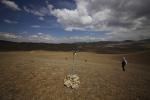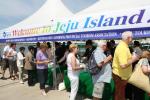| |
 |
|
| ▲ Photo by junior journalist Jeong Yu Jin |
On the fifth trip of the JDC five-month journalism field trip program on May 26, the JDC-Jeju Weekly Junior journalists visited the Kimnyoung Maze Park. The following is one of the reports written by a student. — Ed.
People who know about Jeju may also have heard about one of its most well known tourist attractions, the Kimnyoung Maze Park. This maze was founded by Professor Fredric Dustin in 1995, and it has been featured in TV commercials and dramas. It is one of the top five tourist destinations visited on Jeju, making it one of the most famous places on the island.
Professor Dustin is a peaceful-looking man who was born in America, but he has lived in Korea for about 50 years. He came to Korea as a US Army clarinet player during the Korean War, but after his military service, he became an English professor at several Korean universities including Yonsei, Hongik, and Jeju National University among others. He and his wife came to Jeju because they liked the clean air and the island’s fresh environment.
| |
 |
|
| ▲ Prof. Fred Dustin, founder and owner of Kimnyoung Maze Park. Photo by junior journalist Jeong Yu Jin |
When asked why he built this maze Professor Dustin said, "I built this place for a selfish reason, but not because of money. I needed a reason to stay in Korea. After the age of 65 I would not have a job, so I needed to build this maze to have a job to stay in Jeju. And now I still have a job so I am living in Jeju. Also, I think the money we earned in Jeju should stay in Jeju, so it is definitely not for money."
The maze is made up of 2,232 Leylandii Cypress trees, which come from England. These trees create the hedges, and the hedges create the Kimnyoung Maze.
Though from within the maze it is difficult to tell but seven symbols of Jeju have been incorporated into the maze’s design. All the symbols represent a specific characteristic of Jeju island. For example, the perimeter of the maze was mirrored after the shoreline of Jeju island, a rock located in the maze represents the dolmen showing the shift in Jeju’s history from a hunting society to agricultural one.
In addition, the philosophies of East Asia are represented through a section of the park that has been shaped to resemble the yin-yang, and another area of the maze looks like the head of a horse, an animal that has a long and interesting history on Jeju.
| |
 |
|
| ▲ Photo by Andrew Elwood |
As one can tell from the meticulousness of integrating these Jeju symbols, the maze was not hastily thrown together. In fact it was designed by famous England maze designer Adrian Fisher and it took roughly three years to come up with the basic plan.
Professor Dustin said that there are many benefits to his maze, like the fact that it is ecologically friendly because the hedges can create fresh air like a forest. Also, opposed to some of the other tourist fare on the island, the maze is an adrenalin rush.
Once you enter the maze it is a race to see how quickly you can get out. However, only 65 percent of those who enter make it to the exit and have the honor to ring the bell. The others will go out the way they came in, and even then, 5 percent need to have the rescue squad sent in to help them exit the maze.
Lastly, Professor Dustin mentioned the importance of having fun in the maze park and in life. He wants all those who visit the Kimnyoung Maze Park to have fun.
| |
 |
|
| ▲ Photo by junior journalist Jeong Yu Jin |
|























